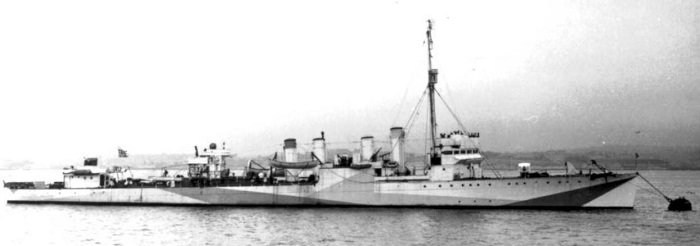|
HMS MONTGOMERY G95
Town Class Destroyer RN
Wickes Class Destroyer USN
This page is not meant to be a comprehensive history of HMS MONTGOMERY, but a record of sailors of the ROYAL CANADIAN NAVY who served in her, photos they took and stories they may have shared with their families.
HMS MONTGOMERY was commissioned in the Royal Navy on 23 October 1940, Cdr. H.F. Nash, (retired), RN, in command. The destroyer underwent further fitting out and familiarization before departing Canadian waters on 1 November, bound for the British Isles. En route, MONTGOMERY and the other of her sister ships in company swept through the scene of the one-sided naval engagement between the armed merchant cruiser HMS JERVIS BAY and the German "pocket battleship" ADMIRAL SCHEER. This action had occurred on 5 November when the German warship attacked a convoy escorted by the erstwhile merchant steamship. JERVIS BAY had gallantly interspersed herself between the raider and the convoy, allowing the latter to escape while being herself smashed to junk and sunk. MONTGOMERY found nothing, however, and after searching briefly for the German "pocket battleship" with orders to shadow by day and attack by night arrived at Belfast, Northern Ireland on 11 November.
Shifting to Plymouth, England, a week later, MONTGOMERY was allocated to the Western Approaches command and based at Liverpool. During the course of one of her early patrols, MONTGOMERY rescued 39 survivors from the torpedoed motor tanker Scottish Standard which had been torpedoed and sunk by U-96 on 21 February 1941. Disembarking the rescued mariners on the 24th, MONTGOMERY resumed her Western Approaches patrols soon thereafter.
The flush-decker underwent repairs at Barrow, Laneashire from April to September and was later assigned to the 4 th Escort Group. Based now at Greenock, Scotland, the destroyer operated between the British Isles and Canadian ports through the end of 1941. On 13 January 1942, the Panamanian-registered steamer SS Friar Rock was torpedoed and sunk by U-180 100 miles southeast of Cape Race' Newfoundland. Four days later MONTGOMERY picked up seven survivors from that ship.
In February 1942, MONTGOMERY came under the aegis of the Western Local Escort Force at Halifax. Later in 1942, the destroyer was loaned to the Royal Canadian Navy before she sailed south and underwent repairs at the Charleston (S.C.) Navy Yard which lasted into the following year 1943. Resuming her coastwise convoy escort operations in February 1943, MONTGOMERY rescued survivors of the torpedoed Manchester Merchant sunk by U-628 on 25 February 1943, 390 miles off Cape Race.
The destroyer remained with the Western Local Escort Force into late 1943, operating out of Halifax. On 12 December 1943, she assisted the Bowater-Lloyd Paper Co. barge Spruce Lake and, on the 27th, departed Halifax for the British Isles, carrying the surviving crew members from the torpedoed British destroyer HMS HURRICANE which had been sunk by U-415 on Christmas Eve.
Arriving in England soon thereafter, MONTGOMERY was placed in reserve in the Tyne River on 23 February 1944. The veteran flush-decker was subsequently broken up for scrap in the spring of 1945 shortly before the end of the war in Europe.
(BL119-BL120) HMCS MONTGOMERY G95 and the Free French submarine SURCOUF, Halifax
From the collection of Cdr Bernard Summers Lake, RCN
Courtesy of Barry Lake
Historical note for the French submarine SURCOUF: SURCOUF participated in the capture of the islands of St. Pierre and Miquelon from the Vichy French on 24 Dec 1941. SURCOUF vanished on the night of 18/19 February 1942, about 130 km (70 nmi) north of Cristóbal, Panama, while en route for Tahiti, via the Panama Canal. An American report concluded the disappearance was due to an accidental collision with the American freighter Thompson Lykes. Steaming alone from Guantanamo Bay on what was a very dark night, the freighter reported hitting and running down a partially submerged object which scraped along her side and keel. Her lookouts heard people in the water but, thinking she had hit a U-boat, the freighter did not stop although cries for help were heard in English. A signal was sent to Panama describing the incident. (source: wikipedia)
|



